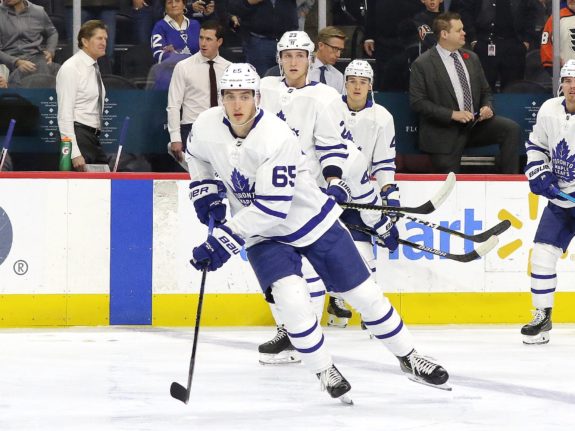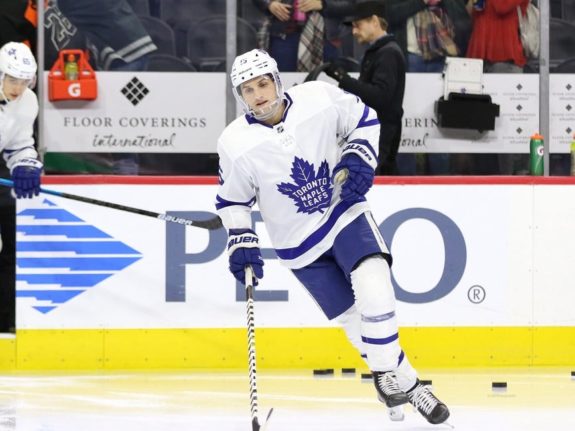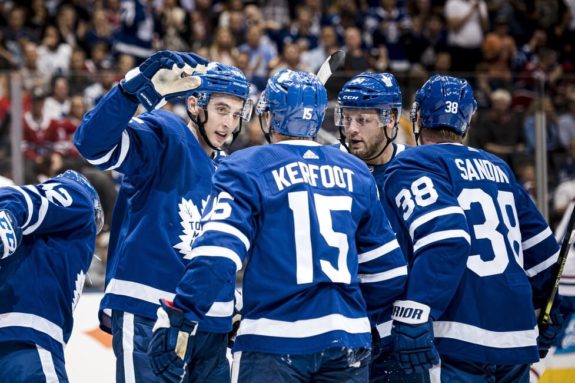After the NHL’s long-awaited return, six teams were in action Tuesday to start the league’s mini preseason. With the Pittsburgh Penguins facing the Philadelphia Flyers, the Toronto Maple Leafs playing the Montreal Canadiens, and the Calgary Flames pitted against the Edmonton Oilers, Tuesday was filled with some longstanding rivalries. The Maple Leafs overcame their rival, beating the Montreal Canadiens 4-2.
Maple Leafs Control Play Against Montreal Canadiens
The Maple Leafs started their return to play with a bang, as Ilya Mikheyev scored just 33 seconds into his first game since Dec. 27. They seemed to control the play for most of the game in a solid win.

It was a pretty balanced attack for the Maple Leafs, as each line showed signs of brilliance throughout the game. Auston Matthews generated various scoring chances, the shifting fourth line made up of Jason Spezza, Kyle Clifford, Pierre Engvall and Frederik Gauthier was aggressive checking in the offensive zone, and Frederik Andersen looked steady between the pipes.
Alexander Kerfoot Steps Up
Out of all the Maple Leafs forwards, it was Alexander Kerfoot that seemed to have the biggest impact Tuesday night. The 25-year-old Vancouver native was brought to Toronto with Tyson Barrie as part of the deal that saw Nazem Kadri get shipped to the Colorado Avalanche — a deal many Maple Leafs fans still look at as a loss.
Related: The Maple Leafs and the Legacy of the Muskoka Five
If he can continue to contribute the way he did Tuesday night, Maple Leafs fans may begin to change their stance on the Kadri deal. On a line with Kasperi Kapanen and 18-year-old Nick Robertson for most of the night, the trio seemed engaged at both ends of the ice.
Kerfoot’s Regular Season Struggles
Throughout the regular season, prior to the COVID-19 stoppage, Kerfoot had not been the impactful player the Maple Leafs were hoping to find. In the last 19 games of the regular season, he had just one goal and seven points. In 65 games, he was able to generate just 88 shots on goal — an average of 1.35 shots per game. In order to produce 20 goals a season at that pace, he would need to almost double his shooting percentage to around 19%.

Kerfoot also spent a chunk of the season playing center where he had struggles winning faceoffs. Of all the forwards with 200+ faceoff attempts, he had the worst of the six skaters with a faceoff winning percentage at 46.9%.
He was also not very involved on the penalty kill throughout the regular season. He averaged just 16 seconds of ice time per game on the penalty kill. To compare, players like Engvall and Kapanen average 1:17 and 1:39 respectively. Overall, the player the Maple Leafs thought they brought over from Colorado had not appeared much in the pre-COVID regular season.
A More Engaged Version of Kerfoot
While it is a small sample size, a lot of the issues that Kerfoot had throughout the regular season seemed to disappear in the exhibition game against the Canadiens. He looked like a different player than Maple Leafs fans had seen, sacrificing the body in his own end and putting the puck in the net at the other end.

I’m sure many Maple Leafs fans flinched as much as I did, as we watched him jump in front of a Shea Weber slapshot in the midst of a Canadiens powerplay during an exhibition game. It is plays like that blocked shot that make you think he has himself in a good state of mind heading into this unique Stanley Cup Playoffs.
Related: Remembering the Canadiens’ 2014 Playoff Run
Kerfoot was also active on the scoresheet, with his line seeming to control the play in the offensive zone. He put two pucks in the net, with one being a brilliant tip off a shot-pass from defender Morgan Rielly. Kerfoot fought off Habs’ defenceman Victor Mete and got his stick on the ice just in time to get one past goaltender Carey Price.
He also cleaned up a shorthanded fast break from Kapanen off a play Kerfoot disrupted in the Maple Leafs end. He intercepted a pass that sent Kapanen on a semi-breakaway, where Kerfoot was able to bang home the rebound and score without even knowing.
Helping at Both Ends of the Ice
His game improved in other areas as well. He won 62% of his faceoffs as the Maple Leafs dominated the faceoff circle, winning 59% of all draws. Kerfoot was also on the ice for a lot more penalty kill minutes than usual. He was on for 3:26 shorthanded, which was fourth amongst Maple Leafs forwards next to Zach Hyman, Mitch Marner and Kasperi Kapenen.
With the bulk of production coming from the Maple Leafs’ top players this season, it was a welcome surprise to see Kerfoot play at the level he did on Tuesday night. The opposition already has two powerful offensive lines to deal with, so if he, Kapanen and whoever their third linemate may be can up their production, the Maple Leafs could be a force to be reckoned with.
Against a top-heavy defensive unit like the Blue Jackets, the Maple Leafs will need players other than their stars to make an impact. If there was ever a chance for Kerfoot to step up and show the hockey world what he can do, it starts in Toronto this Sunday night against the Columbus Blue Jackets.